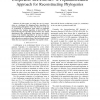54 search results - page 3 / 11 » Improved Phylogenetic Motif Detection Using Parsimony |
BMCBI
2010
13 years 4 months ago
2010
Background: Genomic data provide a wealth of new information for phylogenetic analysis. Yet making use of this data requires phylogenetic methods that can efficiently analyze extr...
CIBCB
2005
IEEE
13 years 10 months ago
2005
IEEE
Abstract— In this paper, we study the use of cooperation as a technique for designing faster algorithms for reconstructing phylogenetic trees. Our focus is on the use of cooperat...
CSB
2003
IEEE
13 years 10 months ago
2003
IEEE
The complexity of the global organization and internal structures of motifs in higher eukaryotic organisms raises significant challenges for motif detection techniques. To achiev...
RECOMB
2008
Springer
14 years 5 months ago
2008
Springer
Abstract. One phylogeny-based approach to horizontal gene transfer (HGT) detection entails comparing the topology of a gene tree to that of the species tree, and using their differ...
GECCO
2006
Springer
13 years 8 months ago
2006
Springer
The most popular approaches for reconstructing phylogenetic trees attempt to solve NP-hard optimization criteria such as maximum parsimony (MP). Currently, the bestperforming heur...

